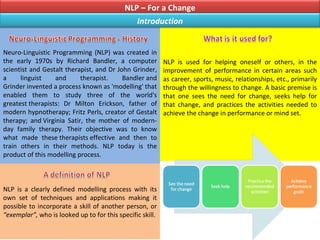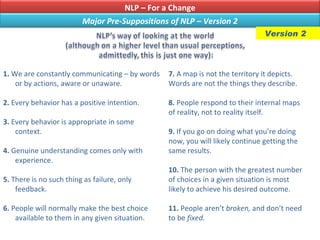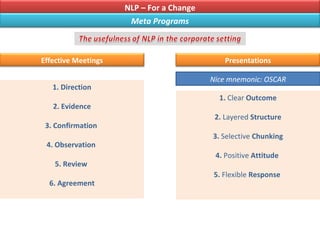Nlp for change-win2003-version
- 1. Neuro-Linguistic Programming (NLP) was created in the early 1970s by Richard Bandler, a computer scientist and Gestalt therapist, and Dr John Grinder, a linguist and therapist. Bandler┬Āand Grinder┬Āinvented a process known as 'modelling' that enabled them to study three of the world's greatest┬Ātherapists: Dr Milton Erickson, father of modern hypnotherapy; Fritz Perls, creator of Gestalt therapy; and┬ĀVirginia Satir, the mother of modern-day family therapy. Their objective was to know what made these┬Ātherapists┬Āeffective and then to train others in their methods. NLP today is the product of this modelling process. NLP is used for helping oneself or others, in the improvement of performance in certain areas such as career, sports, music, relationships, etc., primarily through the willingness to change. A basic premise is that one sees the need for change, seeks help for that change, and practices the activities needed to achieve the change in performance or mind set. NLP is a clearly defined modelling process with its own set of techniques and applications making it possible to incorporate a skill of another person, or ŌĆ£exemplarŌĆØ, who is looked up to for this specific skill. NLP ŌĆō For a Change Introduction
- 2. NLP ŌĆō For a Change General Process Flow
- 3. Predicates Articulate Hear Discuss Listen Loud Ring a Bell Predicates Grip Warm Feel Pressure Relax Rough Hang in There Predicates Hazy Observe Focus Picture See Perceive Appear NLP ŌĆō For a Change Representational Systems and Predicates
- 4. 1. Communication is a constant. 2. The way you communicate elicits a response. 3. People reply to their perceived sense of reality, as opposed to whatŌĆÖs really going on. 4. There should be variety. An element with the most flexibility is usually the controlling element within a system. 5. People make the best choice available to them. 6. All behaviors are constructive in some way 7. There is structure in experience. Chunking. We can achieve anything if itŌĆÖs broken into tiny doses. 8. Usually we have most of what we need. 9. We donŌĆÖt fail. We try, and improve with feedback. 10. When things are out of control, or has slow progress, make a left or right turn and try another route. Version 1 NLP ŌĆō For a Change Major Pre-Suppositions of NLP ŌĆō Version 1
- 5. 1. We are constantly communicating ŌĆō by words or by actions, aware or unaware. 2. Every behavior has a positive intention. 3. Every behavior is appropriate in some context. 4. Genuine understanding comes only with experience. 5. There is no such thing as failure, only feedback. 6. People will normally make the best choice available to them in any given situation. 7. A map is not the territory it depicts. Words are not the things they describe. 8. People respond to their internal maps of reality, not to reality itself. 9. If you go on doing what youŌĆÖre doing now, you will likely continue getting the same results. 10. The person with the greatest number of choices in a given situation is most likely to achieve his desired outcome. 11. People arenŌĆÖt broken, and donŌĆÖt need to be fixed. Version 2 NLP ŌĆō For a Change Major Pre-Suppositions of NLP ŌĆō Version 2
- 6. Matching and Mirroring Voice Tone and Tempo Breathing Rate Movement Body Posture NLP ŌĆō For a Change How to Create Rapport
- 7. 1. Comparisons ŌĆō ex: ŌĆśThis is the best laptopŌĆÖ 2. Universal Quantifiers ŌĆō ex: ŌĆśThe dishes are never doneŌĆÖ 3. Unquestioned Rules ŌĆō ex: ŌĆśThatŌĆÖs the way weŌĆÖve always done itŌĆÖ 4. Unspecified Nouns ŌĆō ex: ŌĆś Someone was hurt in the store yesterdayŌĆÖ 5. Unspecified Verbs ŌĆō ex: hurt how? 6. Cause and Effect ŌĆō ex: ŌĆśWhen youŌĆÖre late, it makes me so angryŌĆÖ 7. Complex Equivalence 8. Lack of Referential Index ŌĆō ex: ŌĆśThey (who?) wonŌĆÖt like itŌĆÖ 9. Mind Reading ŌĆō ex: ŌĆśYou made me look funny in front of the bossŌĆÖ 10. Presupposition ŌĆō ex: ŌĆśDonŌĆÖt cause any more trouble ŌĆś 11. Simple Deletion ŌĆō ŌĆśThings are shaping upŌĆÖ (What things? How?) 2 Simple Meta Programs: Sameness/ Difference Towards/ Away From NLP ŌĆō For a Change Meta Programs
- 8. 1. Direction 2. Evidence 3. Confirmation 4. Observation 5. Review 6. Agreement 1. Clear Outcome 2. Layered Structure 3. Selective Chunking 4. Positive Attitude 5. Flexible Response Nice mnemonic: OSCAR NLP ŌĆō For a Change Meta Programs Effective Meetings Presentations








